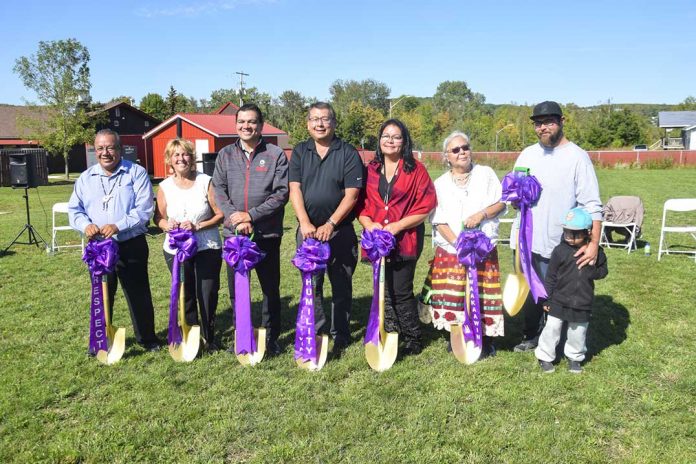SOUTH BAYMOUTH – Artist Jane Woodbury is a self-identified transplanted Brit who grew up in Valley East, but she has always felt a deep affinity to Manitoulin Island, even working for The Expositor in the past for a bit (we won’t go into how long ago that was) before moving onto a gig with the Debajehmujig Theatre Group under the legendary Larry E. Lewis, where she developed an even stronger attachment to Anishinaabe culture.
Ms. Woodbury’s latest works have been strongly influenced by the findings and recommendations of the Truth and Reconciliation Commission.
The artist describes her life as being infused with creativity from conception to the present. “My mother was an art teacher,” she confides, sitting down with The Expositor at the South Bay Gallery to discuss her latest projects. “Mother started a recreation program in 1967 and was chair of the Valley East Recreation Committee. She taught arts and crafts for children and youth.”
Ms. Woodbury has two degrees in the arts—a Fine Arts degree from London’s Fanshawe College and, most recently, an honours degree in English from Laurentian University in 2005. “Yes, you could say that I am an advocate of lifelong learning,” she laughs. She has become deeply involved in the Women in Art program in Thunder Bay and has studied women in popular culture, including film production. “It has expanded my knowledge so much,” she said.
Although she started out her professional artistic career in the traditional forms of drawing, painting, printmaking and performance art, Ms. Woodbury’s repertoire reflects her approach as something of a Renaissance woman in art, including creations in exhibition art, conceptual art and performance art. “Don’t try to pigeon-hole me,” she laughs. Lately she has been turning her hand to sculpture—with a major show in the offing for 2020. “It’s early stages just yet,” she confides. “We are still working out the details.”
Ms. Woodbury’s work ‘Church and Reconciliation’ has been recently chosen as the Manitoulin Fine Arts Association entry in the Northern Ontario Arts Association juried show and the piece reflects her latest creative muse flowing from the TRC recommendations. The exhibit will tour Northern Ontario for one year.
“When the TRC report came out with its 94 calls to action I had begun work on a solo show,” she said. The theme revolves around the two aspects of grief: personal loss and the loss of health and then the reactive depression to the social position you are in.”
While at Debaj in 1989, she began building her knowledge of Anishinabe Culture, which she describes as “inspirational.” Working with folks such as Carl Beam, who provided pottery workshops, and Maime Migwans, whose quillwork creations set the bar high.
“The new show’s title is ‘Sorry M’am’,” she said. “It is an anagram of missing and murdered. The victim aspect of the missing and murdered affects all of us deeply.”
“The TRC calls to action ignited my passion for doing a show that described how I felt as a ‘settler’,” she said.
“This time last year I had just finished a film with (videographer) Warren Rudd that focussed on the families of three missing Tla-o-qui-aht hunters,” she said.
There was a bit of a homecoming in exhibiting with the MFAA at the Centennial Museum of Sheguiandah for Ms. Woodbury. “I was the first person to exhibit in the gallery there,” she recalled. “I remember saying to Linda Kelly, the curator at the time, that the light in what became the gallery space was wonderful.”
Ms. Woodbury recently presented a plan for an art facility to the Central Manitoulin Old School Repurposing Committee that included an art gallery and space for workshops, individual studios and arts and crafts sessions, all spearheaded by seniors. This year she has worked on the big head sign for the Central Manitoulin Community Garden.
One of the pieces completed for her new show illustrates the connection to the TRC calls to action and the commission findings. Entitled ‘Alberta,’ the piece utilizes the image of a murdered Indigenous woman, 20-year-old Alannah Jemima Cardinal, along with roses and barbed wire. “The piece uses the provincial flower and then expands upon it,” said Ms. Woodbury. Ms. Cardinal went missing on July 16, 2016 in the Goodfish Lake area, located about 185 kilometres northeast of Edmonton.
Ms. Woodbury is cautious in her work to avoid appropriation or misusing cultural and sacred images. “It’s not illegal,” she notes, “but it is definitely not cool.”
She hopes her work will provide something of a bridge in the cultural divide between cultures, the Indigenous and the settler.




